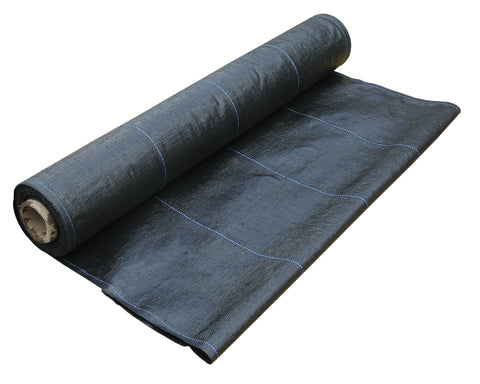FREE SHIPPING
2M x 10M
Landscape fabric is a textile material used to control weeds by inhibiting their exposure to sunlight. The fabric is normally placed around desirable plants, covering areas where other growth is unwanted.
WHAT STABILIZES SOIL, RETAINS moisture, saves on mulch, aids in filtration, reinforces and protects, and oh, yes . . . minimizes weeding? The answer is landscape fabric. Commonly known as a weed-barrier, landscape fabric isn’t just for weed control. It’s a multi-tool rolled up in a convenient, easy-to-use package.
Keeping weeds at bay
One of the major uses of landscape fabric is to help control weeds in planting beds, under decks and beneath patios and paths. Fabrics work to block weed growth by shutting out light while allowing air and moisture in.
For many years, plastic sheeting was used for the job of weed control. While plastic is very effective at suppressing weeds, it also has a serious side effect that makes it a poor choice in planting beds. “If you use plastic, you suffocate the soil,”says expert gardener,and also, “You suffocate the living organisms, and the soil dies.”
Plastic prevents the air and moisture exchange necessary to maintain healthy soil ecology. Even when holes are cut into plastic to allow for plantings, the moisture and nutrient-starved soil underneath most of the bed prevents plants from thriving as they grow and their roots extend. Like plastic, fabrics block the weeds, but they do it while allowing soil to breathe.
When used in planting beds, fabrics don’t just let moisture in, they also help keep it in. “Landscape fabrics limit evaporation, so they are very important for water conservation,” says Steve Gambla, president of Ground Cover Industries, Arlington, Texas.
Using landscape fabric adds value to an installation without a lot of extra expense. “Fabric is such a minute expense in a landscape job,” says expert gardener. “You may spend RM430 in fabric on a $12,900 project. It’s a no-brainer. This will add quality to a project with very little extra cost.”
“We primarily use it in flower beds and underneath trees,” says Chad Snyder, owner of Snyder Landscaping and Lawn Care in Mitchellville, Iowa. “There’s definitely a big difference when you use it. You can’t see it, but if it’s not there, you know it. You’re going to see weeds and grasses. If you have it, you’re going to notice a clean flower bed.”
Some contractors use fabric under planting beds whether they use rock or organic mulches. Others use it only under rock mulch because they prefer to allow their organic mulches to decompose freely into the soil. For those who prefer to use old mulch to build new soil, a shorter-term fabric is an option. In this case, the fabric is removed and replaced every few years to allow decomposed mulch to combine with soil.
No matter what kind of mulch is used, installing landscape fabric underneath can significantly reduce the amount of mulching material needed. “Wood mulch will last longer and stone mulch will stay cleaner and last even longer,” says expert gardener.
Fabric keeps mulch from compacting into the soil and also makes it easier to move the material later—for example, if new plantings are added down the road. Organic mulches won’t break down as quickly because they don’t have direct contact with the soil.
Of course, weed control isn’t just for planting beds. It’s also needed under decks, patios, and other hardscapes. “Landscape fabric has been an especially helpful alternative for us under decks,” says Berg. “We used to put stone down to keep weeds from growing. Now we just put down the weed barrier, add a little weight on it, and staple it down. It’s saved us quite a bit on material for that application.”
Installing weed barrier
To get the most weed protection from any landscape fabric, it’s important to prepare the site and remove as many existing weeds as possible. “We always recommend that you start with a pre-emergent herbicide to make sure you kill any vegetation before you install,” says Gambla.
Ground should be smooth and free of debris to ensure good contact. Weed barrier can be installed either before or after planting, depending on the size of the bed, the spacing of the plants and the preference of the installer.
If plants are installed after the fabric has been put down, the fabric is sliced with “X’s” where plants will be inserted. Then the flaps are folded away to make a hole. After plants are inserted, the fabric is folded back close to the plant base. If fabric is to be placed after planting, X’s are measured, marked, and cut into the fabric before it is laid down. Then the fabric is placed over the bed and the plants are pulled through X’s.
When laying fabric, it’s important to overlap pieces to make sure there are no gaps that would allow light in. It’s also important to fasten the fabric securely with pins around the edges and at the overlaps to keep it from shifting and to keep determined weeds from pushing their way up far enough to catch some rays.
“Make sure you overlap sufficiently,” says Snyder. “If you don’t you’re going to have weeds that will squeeze through. When laying it out, make sure you extend it well over the edging. It’s always easier to overlap the edging and trim it off later than to come up an inch or two short.”
Multitasking
Weed control is just one way today’s high-tech fabrics are used in the landscape. They’ve become a multipurpose tool for many jobs that require filtration, separation, stabilization, or an additional protective, permeable barrier.
Used as a stabilizing layer and for separation under pavers or crushed rock paths, they minimize the effects of frost heave, and prevent pavers and aggregates from sinking into the subsoil.
“It works very well for any job where you need a water-permeable membrane,” says Glenn Richardson, landscape designer with Cedar Run Landscaping, Aldie, Virginia. “We use it frequently underneath concrete pavers. Despite all of the ground preparation we do, there might be a chance for settling. The landscape fabric will help even out the stresses. This is especially important in any kind of driveway situation.”
Fabric also has many uses when it comes to filtration. It’s used around perforated pipe, in trench drains, and behind retaining walls. “One of my favorite uses is in dry stream beds used for surface drainage,” says Richardson. “We line the bottom of a ditch with gravel and perforated pipe to redirect runoff. We put the fabric between the gravel and the soil to keep soil from infiltrating the gravel and the pipe.”
Landscape fabric is also frequently used as an economical protective layer under ponds and other water features. “This is a good way to help ensure that we don’t have punctures from roots into the liner membrane,” says Lim. “It will also help control movement of soil under a new pond.”
Lim uses it in pond applications as well. “It serves as a conduit under the rubber liner to allow for gasses to dissipate. It also protects the rubber liner from sharp edges.”
Lim says fabric has enabled him to create cleaner, higher-quality ponds with less material costs. “We used to put down three to five inches of fine sand, then the pond liner, then a sand soil mix on top of the liner. There was the expense of purchasing the sand and the expense of hauling it. The water would be cloudy until the sand soil mix settled.”
“Now, I can run a fabric down there as a buffer and put rock right over the liner. The fabric protects the liner and we’ve also minimized the cloudiness of the water. It saves material and a lot of effort and also provides a cleaner more established product,” Lim continued.
Not all fabrics are suited to all purposes. To avoid project failure, only use fabrics that are specifically recommended for a particular application. In general, woven fabrics have lower permeability but higher strength. This makes them suitable for landscape applications in addition to stabilization applications. Spun bond fabrics are generally more permeable and are suitable for landscape as well as drainage, filtration and soil separation needs.
You don’t see them. They’re hidden away under mulch, beneath patios, and behind walls. But today’s high tech fabrics are working hard to keep landscapes looking good.
Specification:
2m(width) x 10m(Height) High Quality Landscape Fabric
Note : This dimension of landscape mattress is considered BIG enough for any applications, at least bigger than the mattress usually sold in market.

We are from Johor, We only ship with Poslaju for sarawak sabah buyers
WHY PURCHASE FROM NURSERY KEBUN BANDAR?
~FASTEST SHIPPING IN THE MARKET TO MOST OF THE MAJOR CITIES
~24 HOURS CUSTOMER SUPPORT
~SHIPMENT MONITOR
~CURING AND TREATING PLANTS BEFORE SHIPPED
~SPECIAL REQUEST ACCEPTED EG: GIFT FOR PARENTS
~FREE NEWSLETTER
~FREE SHIPPING
~NO GST
We SPECIALISED in SHIPPING LIVE plants.
Pokok sampai sabah sarawak masih segar lagi.
Please Whatsapp us at --> click here https://www.wasap.my/60127170768/landscapefabric
Join our Facebook group "kebun bandar : jom tanam semua"
Link : https://www.facebook.com/groups/217342735346822/
KBJTS FB PAGE : https://www.facebook.com/nurseryKBJTS/
KBJTS WEBSITE: https://www.nurserykebunbandar.com
